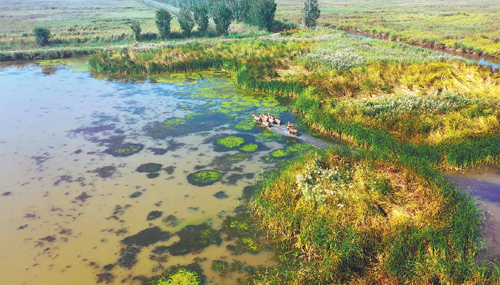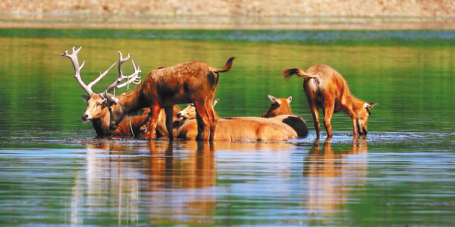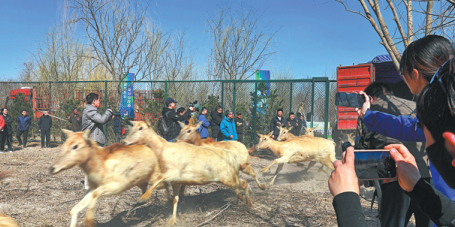MILU DEER ADAPT TO NEW HOME IN TIANJIN
Conservation drive attracts species to return and thrive in Qilihai Wetland

A herd of milu deer is adapting to its ancestral home after being transported to Qilihai Wetland in Tianjin. The 58 deer arrived on March 19 after a 16-hour journey from Dafeng Milu Deer National Nature Reserve in Yancheng, Jiangsu province.
Milu deer, also known as Pere David's deer, are native to the Qilihai Wetland in Tianjin's Ninghe district.
The deer have inhabited the wetland for thousands of years, with archaeological findings in the area uncovering over 30 fossilized and semi-fossilized milu antlers, dating back between 3,000 and 4,000 years. However, in more recent years the wetland environment at Qilihai became degraded and the local milu population dwindled.
This latest initiative aims to restore the native species and enhance wetland conservation.
To revive this rare species and restore the ecological balance of the coastal wetlands, Ninghe introduced 10 milu deer from Beijing Milu Park in 2011. Since then, the ecosystem in Ninghe has supported their reproduction, increasing the population to 34.
Last year, two additional milu deer were introduced from Jiangsu.
"Qilihai Wetland provides an ideal environment for milu deer, offering abundant food sources such as reeds, cattail roots and aquatic plants," said Yu Zenghui, a government adviser to the administrative committee of Qilihai.
"With the expansion of the population and genetic diversity, the herd is expected to become stronger and more resilient, with at least 10 new births projected annually," he said.
Xie Shengbin, director of the milu research institute at Dafeng Milu Deer National Nature Reserve, said, "We carefully selected robust individuals from a population of nearly 1,000, ensuring they are in good physical condition and ready to adapt to their new surroundings."
To facilitate long-term monitoring, five of the deer have been equipped with satellite tracking collars to track their behaviors.
Since 2017, a total of 20 billion yuan ($274 million) has been injected to the area to protect the environment, and a major ecological rehabilitation campaign has been launched after moving all the fishing, farming and tourism business projects nearby. "To prepare for the migration of a large number of migratory birds and ensure an adequate food supply, we released 220,000 fish and shrimp fry last year," said Tian Xiujing, director of the Qilihai Wetland Nature Reserve Administrative Committee.
The area has revealed an ambitious plan to build itself not only into a national model for wetland ecological restoration, but an internationally renowned bird habitat, and an international coastal wetland science education base, Tian said.
Last year, large fish such as silver carp and common carp were auctioned for charity, raising nearly 1.8 million yuan, all of which was allocated to wetland ecological protection. The number of bird species has risen from 182 a decade ago to 258 today, and the annual number of birds stopping over has doubled from around 250,000 to nearly 500,000.
Globally near-threatened bird species, such as the Oriental stork, Eurasian spoonbill and reed parrot-bill have returned to Qilihai.
The variety of wild plant species in the wetland has increased to 162.




Today's Top News
- China to continue anti-dumping duties on EPDM imports
- Trump says war with Venezuela remains possible -- NBC News
- China urges Japan to stop challenging intl bottom line with its nuclear ambitions
- US arms sales to Taiwan a dangerous gambit: Editorial flash
- Taiwan opposition lawmakers announce plan to impeach Lai Ching-te
- Boosting consumption will be key in 2026






























